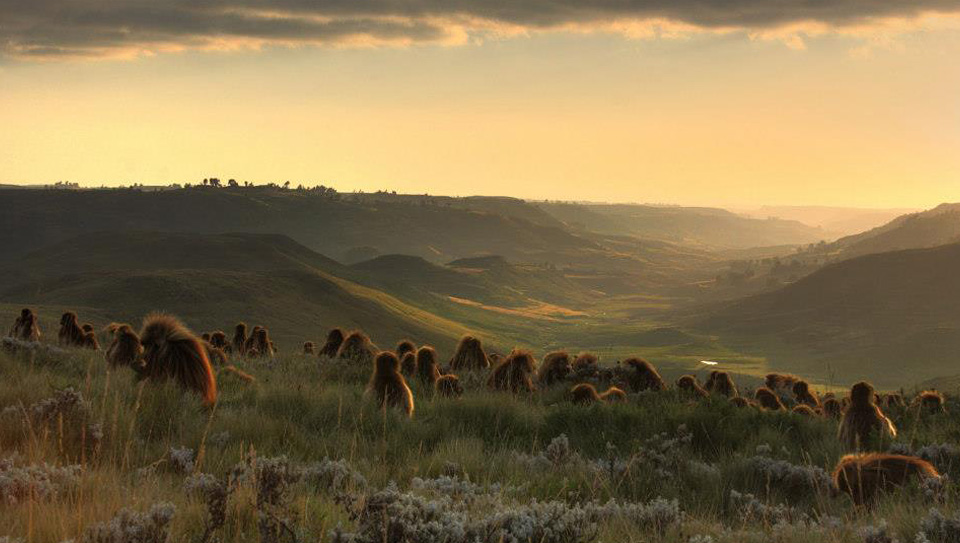Community Conservation Areas in Ethiopia
The biodiversity of Ethiopia is extraordinary with many rare and unique species inhabiting its forests, lakes, and high plateaus. Within these ecosystems there are rare flora and fauna including 625 endemic plant species, 16 endemic birds’ species, and 35 endemic mammal species, found nowhere else in the world.
Ethiopia also harbors a number of charismatic and endemic flagship species, most notably the gelada baboon (the world’s only grazing primate), the mountain nyala, the Ethiopian wolf, the walia ibex, the dibatag, and the giant lobelia. In the Gambella region, the country shares with Sudan the second largest mammal migration in Africa approximately one million individual animals including White-eared kob.
The wildlife and forest areas of Ethiopia have huge value to people locally, nationally, and internationally through the environmental services they provide. This includes direct goods and services from grazing or forest products such as honey or coffee, as well as climate stabilization, carbon sequestration, erosion control, etc. These areas are often center pieces of wetlands and watersheds and thus provide clean water and regulate river flow. For example a number of important rivers such as the Nile, Awash, and Wabe Shebelle flow from Ethiopia’s highlands and sustain over 20 million people and their livestock downstream of Ethiopia, Somalia, Sudan, and Egypt.
Ethiopia’s natural heritage is however under severe threat of extinction. Eighty-five percent of Ethiopia’s 85 million people are almost entirely dependent on natural resources such as soil, grazing land, timber, and fuel wood for their livelihoods. The ever increasing human population is causing environmental degradation throughout the country and an accelerated rate of habitat loss. The last remnants of Ethiopia’s natural ecosystems, including many globally unique species, face an uncertain future, as those people are dependent on natural resources. Ethiopia desperately requires solutions to conserve its remaining biodiversity and ecosystem, whilst striving to ensure sustainable livelihoods and reducing the vulnerability of resource-dependent communities.
Recently, partnership between government and donors has begun to address conservation through community involvement. Communities are seen as key partners for conservation in Ethiopia and a strong network of participatory forest and wildlife management areas is currently being developed throughout the country, with considerable success.
The development of tourism also is seen as a key initiative to assist communities in benefiting more from their natural resources. Not only does tourism provide additional income for the management authorities of naturally protected areas but it also helps communities understand the latent value of their natural resources. Through tourism, communities can reap the benefits of their natural resources over and over. Both government and non-government conservation actors are therefore involved in developing tourism and ensuring revenue flows to communities.
Guassa Community Conservation Area
 Guassa Community Conservation Area, located along one of the most significant historic routes in Ethiopia, offers spectacular Afromontane landscapes on the Guassa Plateau. Trek on foot or travel by mule to experience Ethiopia’s unique natural and culture heritage and traditional village life in the Ethiopian highlands. Discover breathtaking views filled with endemic birds and mammals such as the iconic Ethiopian wolf and the charismatic gelada. Guassa Community Conservation Area is found in Amhara National Regional State, North Shoa Administrative Zone and in Menz-Gera MidirWoreda(district), 260km northeast of Addis Ababa by road. The area is among the Ethiopian highlands’ most pristine and secluded natural wonders. Along the 90-minute drive (80km) from Tarmaber, the hustle and bustle of urban life fades into the slower pace of a traditional Menz village.
Guassa Community Conservation Area, located along one of the most significant historic routes in Ethiopia, offers spectacular Afromontane landscapes on the Guassa Plateau. Trek on foot or travel by mule to experience Ethiopia’s unique natural and culture heritage and traditional village life in the Ethiopian highlands. Discover breathtaking views filled with endemic birds and mammals such as the iconic Ethiopian wolf and the charismatic gelada. Guassa Community Conservation Area is found in Amhara National Regional State, North Shoa Administrative Zone and in Menz-Gera MidirWoreda(district), 260km northeast of Addis Ababa by road. The area is among the Ethiopian highlands’ most pristine and secluded natural wonders. Along the 90-minute drive (80km) from Tarmaber, the hustle and bustle of urban life fades into the slower pace of a traditional Menz village.
The area is managed through a common property resource system by the communities living adjacent to the Guassa Area. This indigenous management system has been traced back to the 17th century and is one of the oldest conservation management systems in Sub-Saharan Africa. At present, Guassa communities live in nine kebeles (farmers’ associations) adjacent to Guassa Community Conservation Area. The area is managed by the Guassa Conservation Council which has kebele and woreda level components and consists of both community and local government representatives.
Guassa Community Conservation Area offers a wide variety of products and services, ranging from four-day treks to single night stays with short hikes. Visitors can discover a traditional Menz village and enjoy longer trekking experiences, mule rides and overnight wilderness camping. The income generated by tourism is returned to the community and supports the conservation of the Guassa GCCA.
AbuneYoseph Community Conservation Area
 Covering some 70 square kilometers of Afroalpine habitat and spectacular scenery, the AbuneYoseph Community Conservation Area (12°12’N, 39°12’E) is found north of the city of Lalibela in the Amhara National Regional State in the North Wollo Zone and LalibelaWoreda (district).
Covering some 70 square kilometers of Afroalpine habitat and spectacular scenery, the AbuneYoseph Community Conservation Area (12°12’N, 39°12’E) is found north of the city of Lalibela in the Amhara National Regional State in the North Wollo Zone and LalibelaWoreda (district).
The AbuneYoseph massif, with a maximum altitude of 4,284m, is placed on the very extreme of the northeastern edge of the Ethiopian highlands. It is part of the northwestern highland massif surrounding and defining the upper Tekeze River, and is limited to the east by the fault escarpment of the Rift Valley depression. The ridge continues northwards to the Tigrean Plateau through lower systems and westwards to the Simien Mountains (4,600m), which is connected by a chain of lower mountain systems (1,000–2,000m).
Visitors with little time to go for trekking in National Parks can obtain a similar experience seeing Abune Yosef. It contains natural phenomena with areas of unique natural beauty and aesthetic importance. Visitors get village tours and wander the wildlife. Abuna Yosef is a prominent mountain near the eastern escarpment of the Ethiopian Highlands. At 4,260 metres (13,976 ft) it is the 6th tallest mountain in Ethiopia and the 19th highest of Africa. It is located in the Lasta massif in the SemienWollo Zone of the Amhara Region.
The AbuneYoseph area is made up of a diversity of vegetation types including bushlands, woodlands, montane dry forests, and Afroalpine grasslands. The massif is made up of three main ecosystems: the montane dry forest, montane grassland and the Afroalpine ecosystem, which exist in altitudinal belts from 2,000 to 4,284m. All of these ecosystems suffer as a result of human intervention by means of agriculture and livestock grazing, although the higher altitudes suffer to a lesser extent.
The montane dry forest exists between 2,950 and 3,300m. The dominant species are Erica arborea, Hypericumrevolutum (St. John’s wort), African juniper (Juniperusprocera) and Rosa abyssinica (the only wild rose in Africa). The densely vegetated forest, placed on the northwestern slope, sustains a large diversity of mammals and birds.
Between 3,300 and 3,600m, tall grasses, giant lobelias and different thistles become more frequent. This area is the montane grasslands. Moving upwards from 3,600 to 4,285m, the vegetation changes rather abruptly into moorlands covered with the shrubby vegetation of Euryopspinifolius (charenfe).
